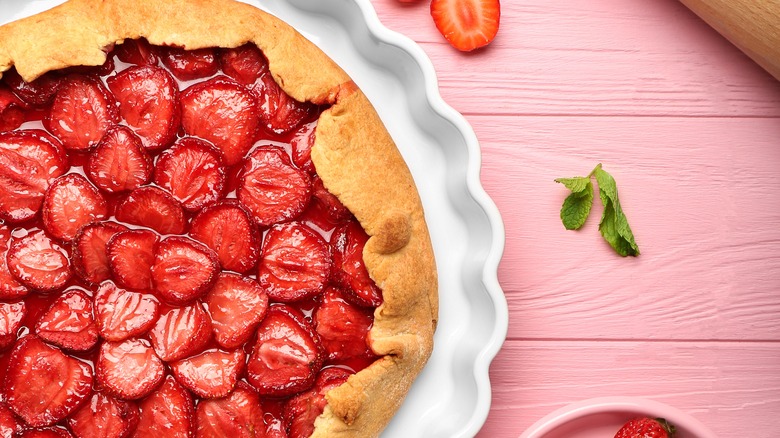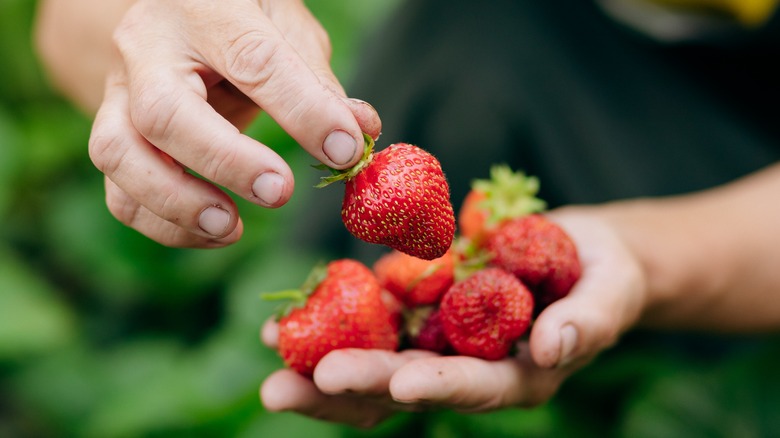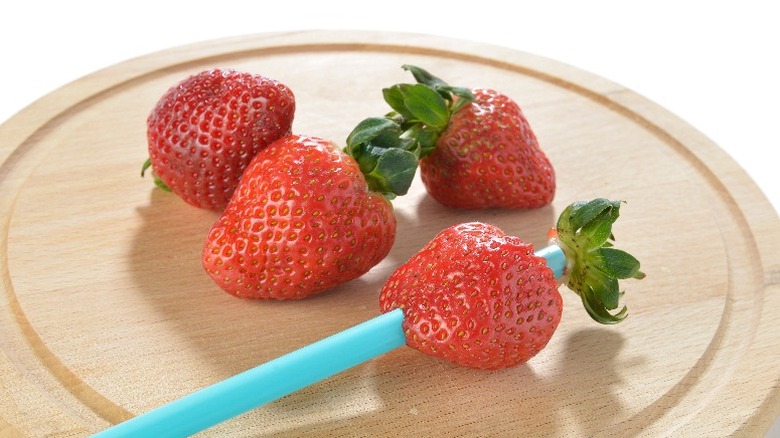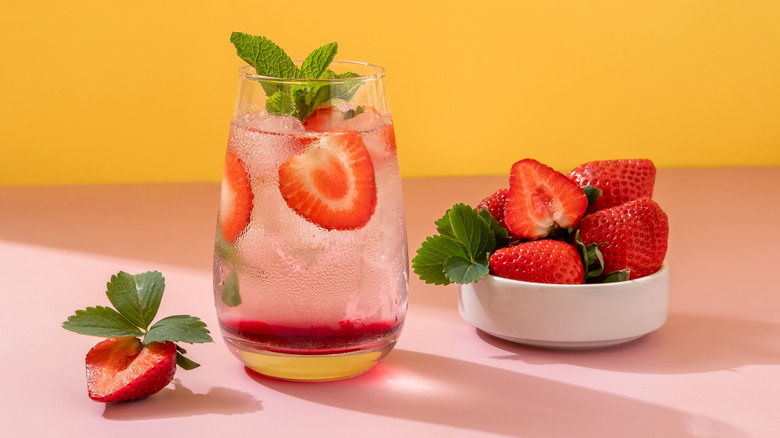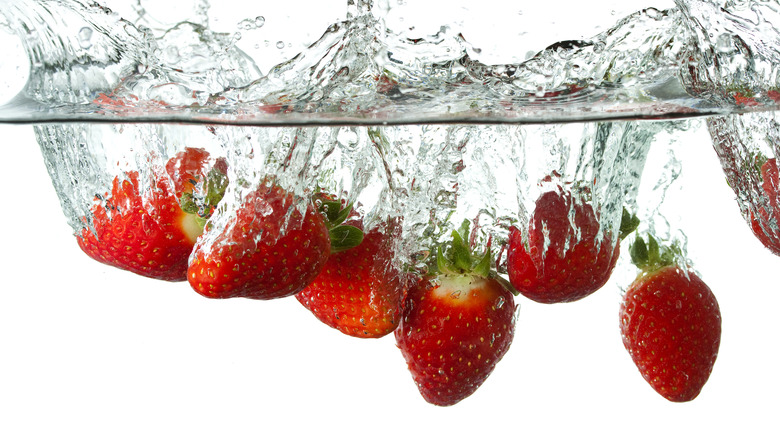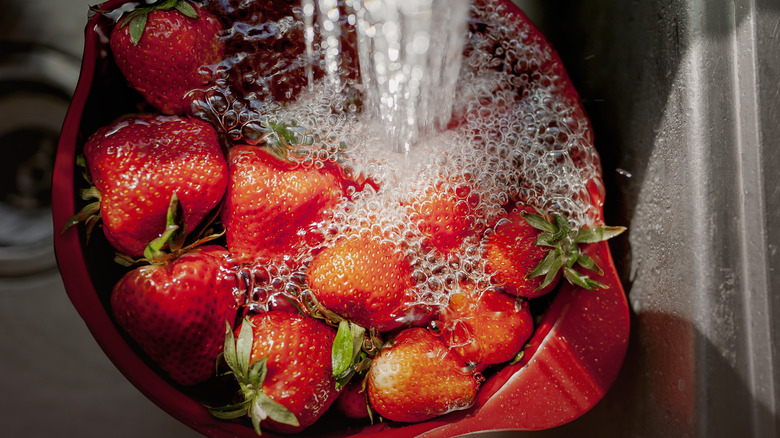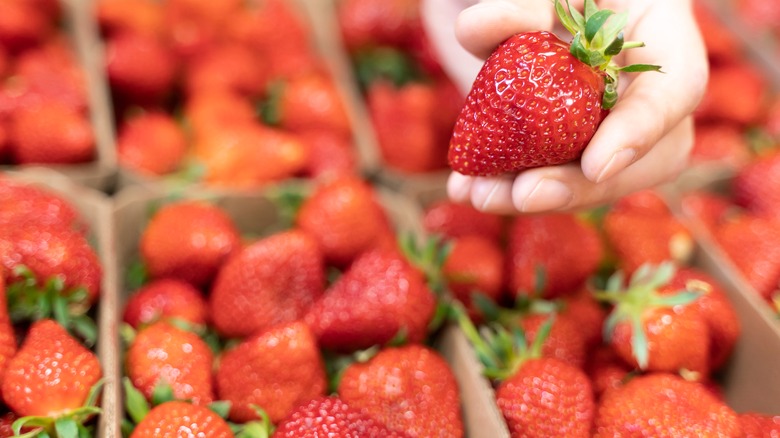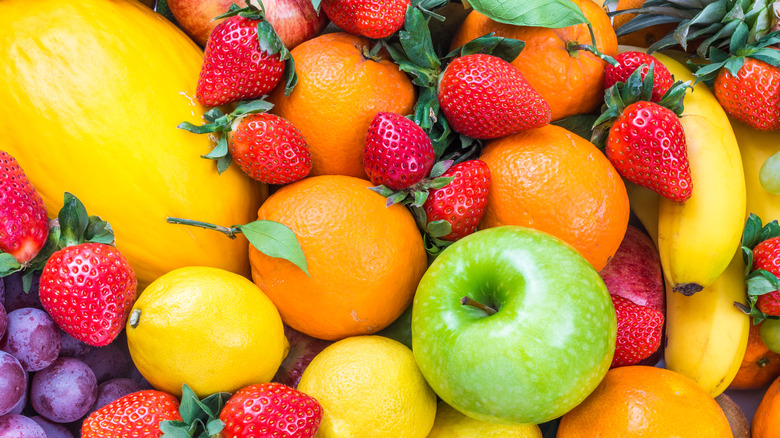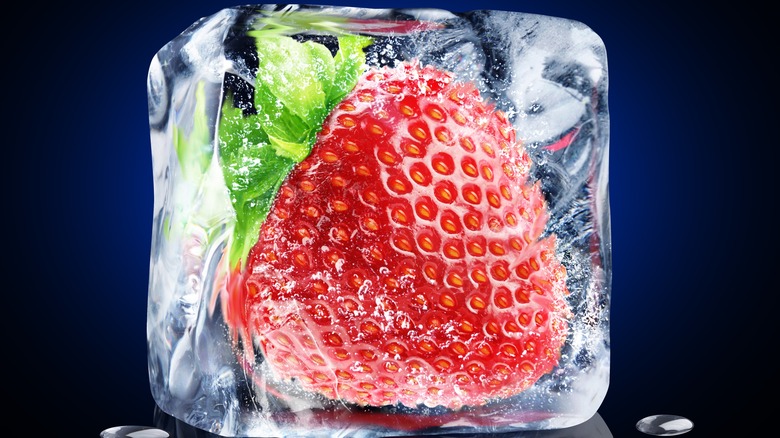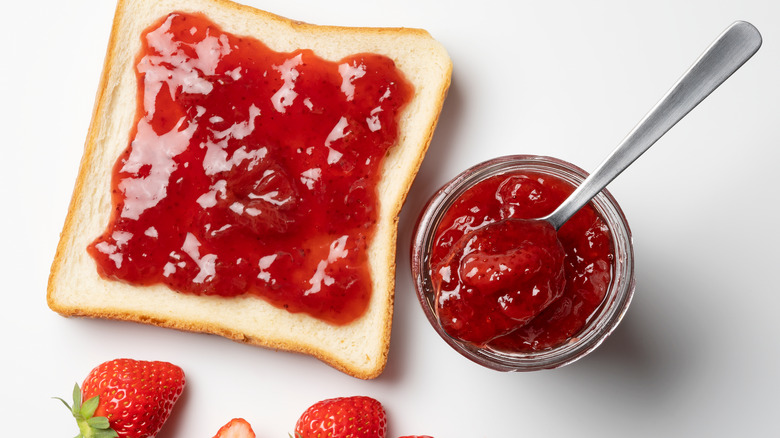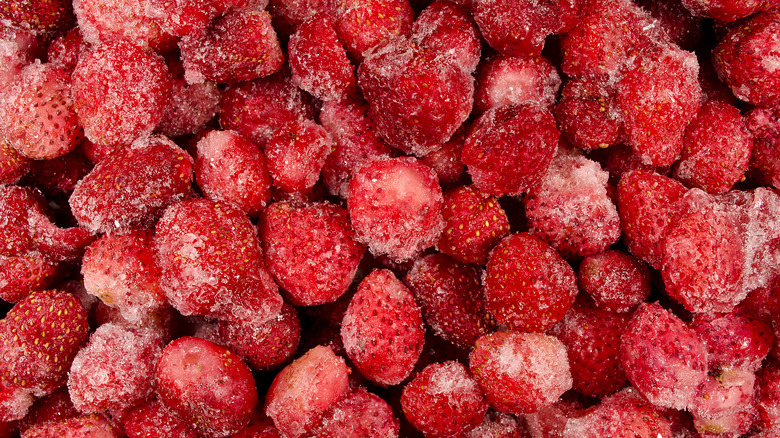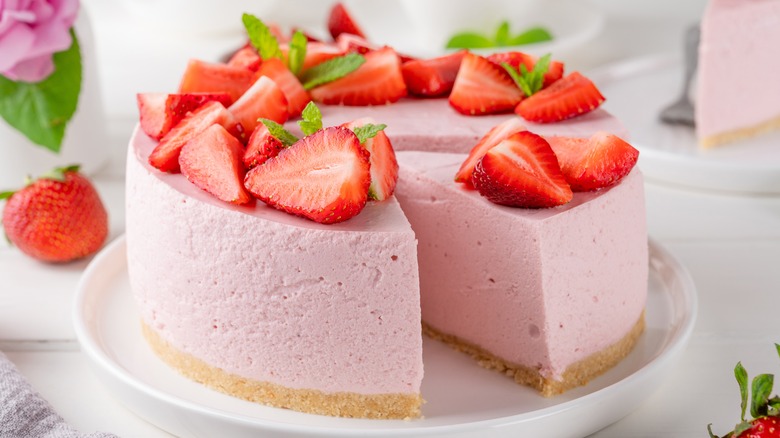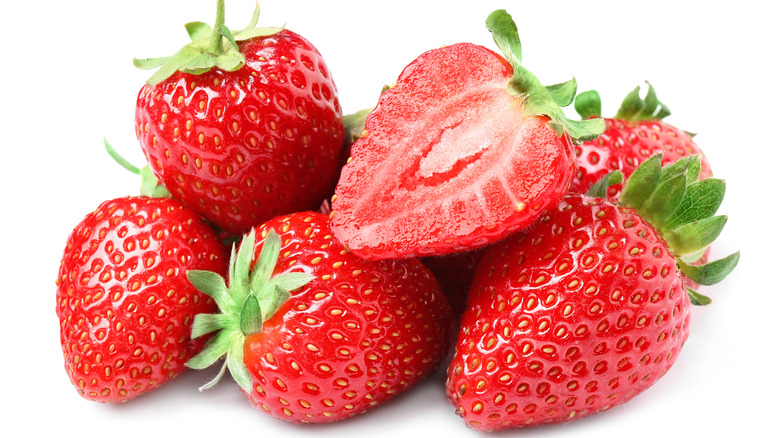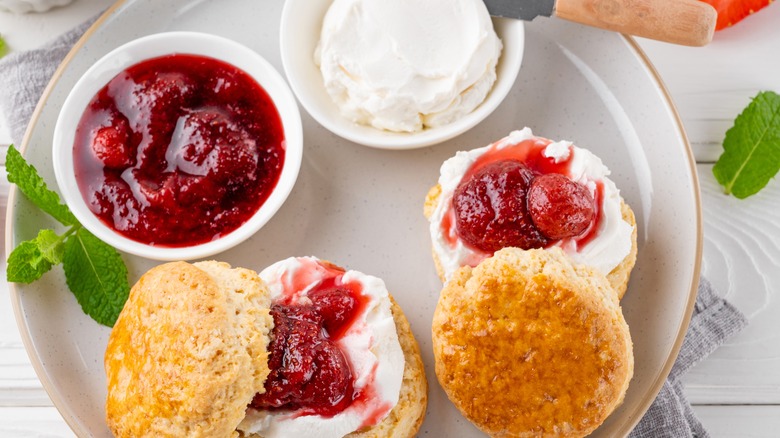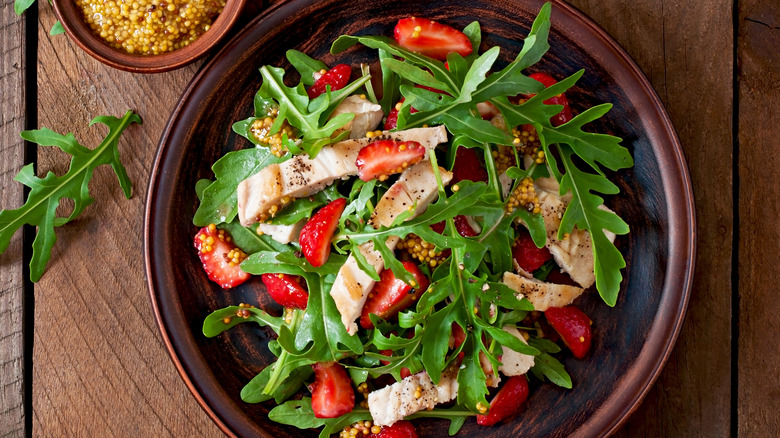14 Tips You Need When Cooking With Strawberries
From strawberry picking under the summer sun to savoring chocolate-covered strawberries on Valentine's Day, strawberries live large in our collective memory. Unlike everyday fruits such as apples or bananas, strawberries are special. Not only are they eye-catching and full of flavor, but they're also ephemeral. Fresh ones are only around a few weeks each year and if you miss the season, you're left eating subpar (or frozen) berries for the rest of the year.
Given their superstar status, treating strawberries with the reverence they deserve only makes sense. To that end, we've compiled a list of tips to help you make the most of your precious stash. After reading this list, you'll know how to keep your strawberries fresher longer. You'll also learn head-removing hacks that will save you time and money. Plus, we'll share all kinds of recipe ideas you've never heard of. From compote to strawberry salsa, you'll never look at strawberries the same way again.
Use the twist-and-cut method to remove heads
Bright red skin, bursting with flavor, and versatile — there's not much we dislike about strawberries. But if we had to choose something to gripe about, it would probably be the annoying task of removing strawberry heads. It takes forever, and it feels like we're wasting all kinds of valuable fruit when we lob off the stiff green head with a knife. Luckily, we discovered a tip to remove the head that's quick and relatively painless. On top of that, using this method ensures that you'll cut off as little actual fruit as possible.
To take advantage of this handy hack, hold the strawberry in one hand and use the other hand to twist the top until it pops off. You'll be left with the flat white part of the fruit. Next, use a paring knife to scoop out the bitter white section. After successfully removing this part, you'll have a ready-to-eat strawberry. It's a simple trick, but it will save you a lot of fruit in the long run.
Straws also help for removing stems
The twist-and-cut method for removing strawberry heads is one of the best ones we've found. However, we recognize that this method isn't perfect. For one thing, it still requires you to use a knife. Unless you've got some serious skills, this could mean a soupy mess and a few nicks on your fingers. Plus, the twist-and-cut method is slow going. If you've got a big bowl of strawberries to de-stem, you'll be in for a long night.
To combat these downsides, we recommend another one of our favorite strawberry de-stemming methods, the pierce-and-push. A plastic or metal straw is all you need for this trick. Stick your straw into the bottom of the fruit until you pierce a hole in it. Then, use the straw to channel through the strawberry until you reach the head. With a final push, you'll be able to remove the leaves. Compared to the twist-and-cut method, the pierce-and-push takes mere seconds. That makes it a great option when you have dozens of strawberries to prep. The only downside is that you'll lose some fruit along the way. However, that's a small loss if saving time is your goal.
Don't throw away the heads
All this talk about how to remove strawberry heads reinforces the idea that the leaves have no purpose. We're here to tell you that's simply not true. To be clear, strawberry heads are tough and bitter. You won't want to casually snack on them, but we're here to encourage you not to throw them away.
One way to use whole strawberries is by throwing the berries (greens and all) into your morning smoothie. Not only will you save time, but you'll reduce food waste. On top of that, you'll get an extra kick of nutrition. Strawberry tops are full of vitamin C, and strawberry leaves are also rich in chlorogenic acid, a metabolite with antioxidant and anti-inflammatory properties. Besides smoothies, strawberry heads make for tasty infused drinks. Some popular uses include flavored water, tea, and kombucha. You can even use strawberry heads to give your adult beverages a new look and flavor. If you're going the cocktail route, we recommend using clear spirits like vodka, gin, and rum.
Maintain strawberries' freshness with a vinegar-water bath
Remember when we said there weren't many things we disliked about strawberries? Well, there's another one we forgot to mention — their incredibly short shelf life. Outside of the fridge, you're lucky to get one or two days of freshness before mush and mold colonize your berries. Even if you refrigerate them, you're looking at a week of firm fruit at the most. That is unless you treat them to a vinegar and water bath before storing.
To keep your strawberries fresh, submerge them in a vinegar-water solution. The ideal ratio is one part vinegar to three parts water. Strawberries are porous (more on that later) so don't keep them under the liquid for more than a few seconds. After dunking, drain and dry the fruit as much as possible. A salad spinner is a great way to remove excess liquid but you can also leave them out to dry on a paper towel. Once dry, store the berries in a container with a lid. Make sure to cover the berries, but don't seal the lid. Done correctly, this method will keep almost all of your strawberries fresh for a week or more.
Don't soak strawberries in water
It's tempting to give your strawberries a thorough scrub after bringing them home, especially if you picked them yourself. While there's nothing wrong with wanting clean berries, you have to be careful about how you wash them. That's because strawberries are a porous fruit (a.k.a. they're spongelike). If you put them under the facet too long or leave them to soak, the fruit will absorb the liquid. This results in flavorless, waterlogged berries. To avoid watery strawberries, give them a quick rinse right before eating. Or, if you're using the vinegar-water bath to keep them fresh, make sure to dunk them briefly before removing excess liquid.
This is all well and good, but what about the reports of people soaking strawberries in a saltwater solution to remove bugs? According to multiple TikTok videos posted in 2020, soaking strawberries for five to 30 minutes in a saltwater solution causes worms to crawl out of the fruit. The worms, which are the offspring of the Spotted Wing Drosophila (SWD), can be removed using this simple method. If you're feeling squeamish about the possibility of eating bugs, go ahead and try this soak. But keep in mind that these worms won't harm you if eaten. So, watery and clean or firm and buggy berries, the choice is up to you.
Store them properly
If it wasn't already clear, strawberries are a finicky fruit. They require a lot of special attention to ensure that they taste their best and last as long as possible. A big part of this equation is making sure they're stored properly. Most berries hold up perfectly well when stored in their original containers in the fridge. Unfortunately, that's not the case for strawberries. These delicate fruits have the tendency to dry out in the fridge, so take special precautions when storing them.
The best way to store strawberries is by placing them on top of a dry towel (kitchen or paper) in the fridge after washing. To ensure maximum freshness, organize the berries into a single layer on the towel if possible. Top the strawberries with a damp towel to prevent them from drying out. It's also a good idea to keep them closer to the front of the fridge. Not only will seeing them on a regular basis remind you to eat them asap, but it will also prevent them from suffering frost damage at the back of the fridge.
Keep apples and strawberries away from each other
Apples and strawberries taste great mixed together in a crumble but keep these two fruits far away from each other prior to cooking. In fact, failing to keep them separated could spell big trouble for your strawberries. To understand why, you need to know about gas; ethylene gas to be more precise.
When it comes to ethylene gas, fruits are divided into two categories: those that produce ethylene and those that absorb it. Before we go any further, it's important to recognize that ethylene is an essential part of ripening fruit. The trouble only comes when fruits from one category come into contact with fruits from the other category. In our example, apples are ethylene producers, while strawberries are ethylene absorbers. If they're stored close together, the excess gas from the apples will cause your strawberries to ripen so quickly that you won't have the chance to eat them. Luckily, the solution is simple. Just make sure to store your apples and strawberries in separate parts of the refrigerator.
Save mushy strawberries with an ice bath
Strawberries are finicky fruits that have the tendency to turn mushy after just a few days. Sure, soft berries are great for making strawberry jam, but sometimes you just want to feel the crunch of a ripe berry between your teeth. If that's the case, there's a simple way to bring mushy strawberries back to life. Before we tell you the secret, we should point out that this hack only works on slightly mushy fruit. If your berries have mold, have changed color, or have started to rot, this isn't the trick for you.
Assuming your strawberries are still salvageable, all you have to do is place them into a bowl, cover them with ice cubes, and add a bit of cold water. Add enough water so the berries are completely submerged and the ice floats. Let them sit for about 20 minutes before removing the water and drying the berries. Believe it or not, you'll be left with brighter, plumper fruit. Even better, you can reuse the water to give your houseplants a drink. Just make sure to let it warm up to room temperature before watering.
Make compote with old strawberries
When life gives you lemons, make lemonade. When life gives you mushy strawberries, make strawberry compote. Now, if you're freaking out about making compote, we're here to reassure you that it's not as tough as you might think. Whereas jam requires you to puree the fruit, add pectin and acid (like lemon juice), and can it, compote is much lower maintenance.
To make a delectable strawberry compote, remove any soft or bruised sections. Next, heat 1 pound of strawberries in a saucepan with 2 tablespoons of sugar, 3 tablespoons of orange juice, and 2 tablespoons of cornstarch. Cook for five to 10 minutes, or until the mixture thickens. Let it cool before transferring it to a jar. Enjoy it as a spread on toast, a tasty yogurt mix-in, an ice cream sauce, or as a finishing touch on cheesecake. Whatever you don't use can be stored for up to two weeks in the refrigerator.
Freeze strawberries correctly
Let's cover a bit of food science before explaining why it's important to freeze strawberries. There are a lot of ways to classify fruits but let's focus on climacteric versus non-climacteric fruits. Climacteric fruits like apples, peaches, and bananas continue to ripen after they've been picked. Non-climacteric fruits like grapes, cherries, and strawberries stop ripening the moment they've harvested.
Because of this feature, it makes sense to stock up on strawberries when they're at their peak ripeness. The only problem with buying a bunch of strawberries at one time is that you won't be able to eat them before they go bad. Thankfully, freezing is an easy solution that allows you to have ripe fruit year-round. To take advantage of this trick, clean and de-stem strawberries prior to freezing. Dry them off, then place the berries cut-side down on a parchment-paper-lined cookie sheet. Freeze for 24 hours. While this step might seem like a hassle, it prevents the fruit from sticking together. After the initial freezing, transfer the fruit into freezer bags or containers. If you're using bags, make sure to remove air as this can cause freezer burn. Stored properly, strawberries will last up to one year.
Know when to use frozen strawberries (and when you can't)
Fresh is almost always better than frozen when it comes to cooking with strawberries. However, price and seasonality matter a lot when it comes to this fruit. So, more often than not you may have to turn to frozen fruit. Usually, you won't notice a huge difference in taste or quality when using frozen strawberries in your favorite recipes. For instance, they're great for making smoothies and jam. It's also totally fine to use them when making baked goods like cobblers, crumbles, and pies.
While there are plenty of instances where you can get away with using frozen strawberries, there are several exceptions. For example, avoid using frozen strawberries when garnishing ice cream or drinks. Frozen strawberries will get mushier and mushier as they thaw, creating a drippy mess on your masterpiece. Fruit salad is another example where you'll want to use fresh strawberries. The freshness and quality of the ingredients are what make fruit salad such a delight. Unfortunately, frozen strawberries just aren't up to the task. Lastly, avoid frozen berries when making chocolate-covered strawberries. Frozen berries are too soft and contain lots of water. The chocolate won't stick to them and you'll be left with a soggy pile of fruit. That said, you can freeze chocolate-covered strawberries to enjoy at a later date.
Know your strawberry measurements
Whether you buy strawberries from the supermarket or pick your own, you'll usually have the option of buying a pint or a quart. These quantities don't matter much if you're just planning to snack on the berries or slice them on top of your cereal. However, standard strawberry measurements are pretty unhelpful if you're making a recipe that measures the fruit in cups. In other words, how do you know how many strawberries to buy when baking?
To help you out, we've compiled some need-to-know measurement conversions to use when cooking with strawberries. For starters, 1 pint weighs ¾ pound and contains about 12 large, 24 medium, or 36 small strawberries. This is equivalent to 2 ½ cups of whole strawberries (small), 1 ¼cups of puréed strawberries, or 1 ½ to 2 cups of sliced strawberries. There are 2 pints in a quart, so 1 quart of strawberries weighs 1 ½ pounds and contains about 24 large or 48 medium strawberries.
Marinating strawberries brings out their sweetness
When it comes to fruit, strawberries are about as sweet as they come. However, if you've only been eating them raw, then you're missing out on a full range of flavors. In order to bring out all of the delicious notes contained in these luscious red berries, try marinating them before serving. As with other marinades, soaking strawberries leads to softer, sweeter, and juicier fruit. Letting strawberries soak for 15 to 45 minutes is also a chance to experiment with new flavor combinations you might not have considered before.
Lime and mint marinated strawberries are a quick, easy way to dip your toes into this new culinary practice. Serve with whipped cream as a dessert. Another classic combo is mint, balsamic vinegar, orange juice, and sugar. After the strawberries have taken a swim, serve them alongside a dollop of mascarpone cheese for an eye-catching summer dessert. If you still need your whistle wet, why not try a marinade of lime, basil, and confectioner's sugar? Serve as an unexpected ice cream topping.
Don't limit yourself to sweet recipes
No one would blame you for only using strawberries in desserts. After all, the season is short. Plus, who can say no to a classic strawberry shortcake or a proper Eaton Mess? Certainly not us. But if you've never tried incorporating these delicious red fruits into your savory dishes, you're missing out in a big way. You may not believe it, but strawberries are incredibly versatile. In fact, this is probably the top tip you need to know when cooking with strawberries. They work in so many dishes because their natural sweetness balances out savory notes.
For example, why not dress up your usual pan-seared salmon with a strawberry basil relish? To make this simple relish, simply chop up strawberries into tiny pieces, then toss them with fresh basil, honey, and some freshly ground black pepper. Or you could try fish tacos with strawberry salsa. This simple sauce takes less than five minutes to make and contains just five ingredients: jicama, strawberries, jalapeño, cilantro, and lime juice.
Static Media owns and operates Tasting Table and Mashed.
